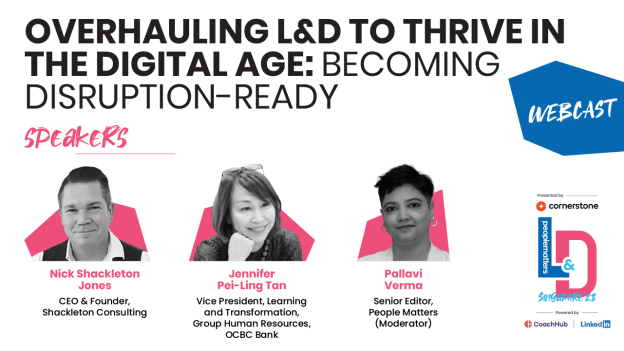Nick Shackleton-Jones and Jennifer Pei-Ling Tan on what you didn’t know about the changing L&D landscape

Skills that are relevant today may become redundant tomorrow with the onslaught of advanced technologies. There is already buzz around the 20 human jobs that ChatGPT 4 can replace. In such a dynamic business environment, how can organisations stay ahead of the curve? How can L&D professionals understand the big and small implications of new phenomena creating an impact on the landscape?
During our discussion on ‘Overhauling L&D to Thrive In The Digital Age: Becoming Disruption-Ready’, a precursor to People Matters L&D Singapore, we explored the top trends, learning needs of companies in Southeast Asia, tackling new-age business challenges, necessary steps to match the skills demand and debated on the critical skills required by leaders to increase their investment in building new capabilities with our speakers Nick Shackleton-Jones, CEO and Founder, Shackleton Consulting and Dr Jennifer Pei-Ling Tan, Vice President, Learning and Transformation, Group Human Resources, OCBC Bank.
While the former speaker shared valuable insights about the significant changes played out in the nature of work, workforce and workplace, the latter talks about moving away from older models to newer ways of thinking.
Skills of the future and the role of ChatGPT
With the conversation around disruptions, like every other human being, Dr Tan also went ahead and asked ChatGPT about the trends set to shape the future landscape of L&D. According to the OpenAI chatbot, personalised learning, micro-learning, gamification, mobile learning as well as data-driven learning will play a vital role. But there’s one thing that most people usually forget when debating with ChatGPT about future trends. Dr Tan shares, “It’s essential to know that ChatGPT’s intelligence data is scraped up to November 2021 so the future trends predicted by it should be taken critically.”
Putting forth an important aspect that might bring a mindset shift, Dr Tan believes we need to be aware that human beings are no longer the most intelligent species on earth. The PhD scholar shares, “With this mindset shift, the way we perceive human beings and therefore the role of an L&D professional will significantly change. In the end, the future of the L&D landscape begins with us - imagining who we are, what our purpose is and the values we bring forth amidst the geopolitical trends and the capital behavioural economics.”
For Jones, the three areas of significant change are the nature of work, workforce and workplace. With automation and AI, work has been changing. With gig workers playing an essential role in today’s economy along with borderless hiring and a younger workforce, there are quite a few stresses and strains there too. And with more people choosing to work from home, the workplace is evolving too. As an L&D professional, he is worried about the way people were learning their jobs pre-pandemic and how it is vastly different from their learning curve now.
True challenge is deskilling and downskilling and not reskilling and upskilling
With global reports and studies pointing towards talent shortage and hiring challenges, the role of learning professionals becomes much more vital. Dr Tan outlines the top three priorities for L&D within OCBC Bank: How can L&D not only create and design impactful learning programs, but also add value to business transformation and growth? How can we enhance the company's appeal as a desirable workplace amidst talent shortages? And, how can we swiftly respond to evolving business conditions?
Jones elaborates on the war for talent that has brought forth a new set of challenges where it has been difficult to hire top talent to WFH where they are restricted to Zoom calls as opposed to sitting in a real office. That’s why he believes that the employee value proposition (EVP) is changing radically. In these times when engagement drops are happening significantly, the author decided to take a practical approach towards what L&D needs to do. “Contrary to what ChatGPT might say, reskilling and upskilling are not the biggest challenge today. It is deskilling and downskilling. We are living in a world where employees are going to be with you for shorter spans of time and you wouldn’t want to spend that time training them. We need to create jobs that are plug-and-play.”
Sharing examples of how AI can play a critical role here, Jones insists on creating performance guidance systems like a GPS navigator for every job so anybody can immediately take it up and do it well. With the new generation that’s obsessed with experiences, there is a rare opportunity for L&D professionals to create remarkable experiences that in turn promotes that sense of belonging, culminating into a culture of learning.
The Learning Needs of the ‘Want-It-All Generation'
As leaders are eager to leap towards the top learning needs, Dr Tan believes that jumping a bit quickly might not be the wisest thing to do. The need of our time is to design for connection, community, to build that belongingness and intrinsic motivation to stimulate discretionary effort. But the want-it-all generation are walking paradoxes who have grown up in largely more affluent countries. “They want everything, they want it personalised to suit their needs and exactly when they want it.”
While technical skills, digital literacy skills and prompt engineering are essential skills, along with leadership skills, I would bet my money on learning agility power, which is the ability to learn, unlearn and relearn. She defines it as “knowing what to do when you don’t know what to do” that’s borrowed from Jean Piaget’s work on fluid intelligence.
Jones chooses three focus areas: induction, leadership and talent. For an induction program to succeed in instilling that sense of belonging, pair an employee with a buddy or a mentor. The idea is to put people in a relationship, right at the start, which can make a difference to your bottomline and be the difference in whether people leave or stay.
With a different world of work, leaders need to lead differently to create the right experience for people. “Leadership capability where leaders can create psychological safety, connect the employees to the organisation’s mission and engage people remotely is an important skill but selecting the right people for these roles is equally important.”
When it comes to talent and personalisation, it simply means that there is a job that needs to be done, the organisation has a job that needs to be done but the competency model that the HR has doesn’t tell you much about that job. That’s why there is a need to move away from competency-based models to skills-based models, where every skill is pinned against a specific task. “It actually enables the L&D team to create personalised learning journeys that are actually relevant to your work. We need to fine-tune the talent model so it is no longer around broad competencies,” feels Jones.
The challenges, obstacles and hurdles to building a learning culture
Jones reveals that most employers don’t have a clue on how to build a culture of learning, especially in a hybrid model. The biggest challenge is that while we want leaders to be more involved in developing people and creating the culture, we also need to equip them with the tools and capabilities to do it. The pioneer in learning believes that too many leaders are still stuck in the past of how things were done and that has to change. “Leaders need to understand better ways of working remotely with teams where the focus is more on productivity, output, people’s work, creating great experiences, collaboration and supporting people.”
Dr Tan believes that there is not a single organisation today that is not facing any challenge when it comes to building the right culture, even with the best tools. We all are in situations where we don’t know what to do but the important thing is to acknowledge the problem and derive a framework of this is where we wish to go and this is the culture we wish to achieve. Dr Tan feels that to co-create a culture together and bring about the transformation, L&D professionals will play a critical role in its facilitation. “I absolutely believe that learning and culture occur by design.”
As we together design the future we all want, the primary challenge, according to Dr Tan, is moving away from enterprise thinking to ecosystem thinking. “While we don’t know how to move or play in the ecosystem model, it is really upon us to stretch the thinking. In Asian countries, the young talent is equipped with procedural skills but lack relational skills: How do we build in this space? To thrive economically, organisations always focus on performance: How do we shift towards purposeful engagement? Efficiency and effectiveness have always been on top in the employer’s book but what about impact and contribution? If we design the ecosystem to relationship to autonomy to purposeful engagement to impact and contribution, I think we will be moving in the right direction.”
The fundamentals to experimentation in L&D
Jones believes that new technology applied to old thinking is not really progress. “Let’s talk about the beginning of L&D when everyone believed e-learning was the next big thing to revolutionise training and learning. But it was a catastrophe and ended up being used for compliance training. With micro-learning, everyone bought these big libraries and nobody uses them now. And there are conversations about using AI systems today to push little bits of learning during the time one is working.”
The truth is technology isn’t going to save you, shares Jones. “The only thing that will save you is a different way of thinking about what you are trying to do. In terms of innovation, one big thing I push for is human-centred learning design and VR depending on the organisation.”
It all boils down to how much you are willing to understand before you are ready to experiment with technology and what others are doing. To meet Nick Shackleton-Jones and Dr Jennifer Pei-Ling Tan in-person and listen to their views on L&D, join us on April 13 at Fairmont, Singapore for People Matters L&D Singapore 23. Click here to register.














